Related Research Articles
Bloody Friday is the name given to the bombings by the Provisional Irish Republican Army (IRA) in Belfast, Northern Ireland on 21 July 1972, during the Troubles. At least twenty bombs exploded in the space of eighty minutes, most within a half-hour period. Most of them were car bombs and most targeted infrastructure, especially the transport network. Nine people were killed: five civilians, two British soldiers, a Royal Ulster Constabulary (RUC) reservist, and an Ulster Defence Association (UDA) member, while 130 were injured. The IRA said it sent telephoned warnings at least thirty minutes before each explosion and said that the security forces wilfully ignored some of the warnings for their own ends. The security forces said that was not the case and said they were overstretched by the sheer number of bombs and bomb warnings, some of which were hoaxes.
The Guildford pub bombings occurred on 5 October 1974 when the Provisional Irish Republican Army (IRA) detonated two 6-pound (2.7-kilogram) gelignite bombs at two pubs in Guildford, Surrey, England. The pubs were targeted because they were popular with British Army personnel stationed at Pirbright barracks. Four soldiers and one civilian were killed. Sixty-five people were wounded.
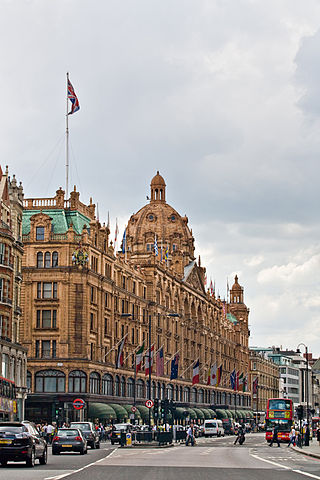
The Harrods bombing refers to the car bomb that exploded outside Harrods department store in central London, England, on Saturday 17 December 1983. Members of the Provisional Irish Republican Army planted the time bomb and sent a warning 37 minutes before it exploded, but the area was not evacuated. The blast killed three police officers and three civilians, injured 90 people, and caused much damage. The IRA Army Council said it had not authorised the attack and expressed regret for the civilian casualties. After the bombing, the IRA shifted its emphasis towards attacks on military targets in England.
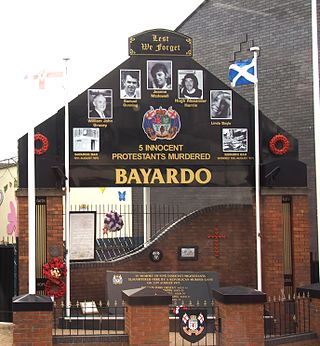
The Bayardo Bar attack took place on 13 August 1975 in Belfast, Northern Ireland. A unit of the Provisional Irish Republican Army (IRA), led by Brendan McFarlane, launched a bombing and shooting attack on a pub on Aberdeen Street, in the loyalist Shankill area. IRA members stated the pub was targeted because it was frequented by members of the Ulster Volunteer Force (UVF). Four Protestant civilians and one UVF member were killed, while more than fifty were injured.
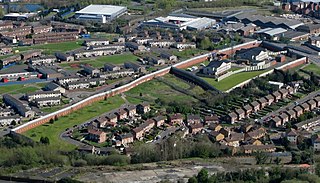
The Battle at Springmartin was a series of gun battles in Belfast, Northern Ireland on 13–14 May 1972, as part of The Troubles. It involved the British Army, the Provisional Irish Republican Army (IRA), and the Ulster Volunteer Force (UVF).

The 1992 Manchester bombing was an attack by the Provisional Irish Republican Army (IRA) on Thursday, 3 December 1992. Two 2 lb (0.9 kg) bombs exploded, wounding 64 people and damaging several buildings in the city of Manchester.

On 27 August 1975 a Provisional Irish Republican Army bomb exploded without warning at the Caterham Arms public house in Caterham, Surrey, England. There were no fatalities, but 33 people were injured, some severely, including three off-duty soldiers who lost limbs.
On Tuesday evening 18 November 1975 an Irish Republican Army (IRA) unit nicknamed the Balcombe Street Gang, without warning, threw a bomb into Walton's Restaurant in Walton Street, Knightsbridge, London, killing two people and injuring almost two dozen others.

On Thursday 9 October 1975, a bomb attack just outside Green Park Underground station in the City of Westminster, London, left one man dead and injured 20 others. The attack was carried out by volunteers from the Provisional IRA's Balcombe Street Gang. The attack occurred during a period of heightened activity by the IRA in England and in particular London and surrounding areas, since the Caterham Arms pub bombing two months earlier in August 1975.
The Balcombe Street Gang was a Provisional Irish Republican Army (IRA) active service unit (ASU) who carried out a bombing campaign in southern England in the mid-1970s. The majority of their attacks and attempted attacks took place in London and the rest in Surrey, Hampshire and Wiltshire. Between October 1974 and December 1975 they carried out approximately 40 bomb and gun attacks in and around London, sometimes attacking the same targets twice. The unit would sometimes carry out two or more attacks in one day; on 27 January 1975 they placed seven time bombs in London.
This is a timeline of the events and actions during the Troubles that were carried out in Great Britain, the vast majority of which were carried out by Irish Republican paramilitaries mainly the Provisional IRA were by far the most active but both the Official IRA and the Irish National Liberation Army, also carried out a number of attacks, which included bombings and shootings. Ulster Loyalist paramilitary groups also carried out a small number of violent actions.

The 1973 Westminster bombing was a car bomb that exploded on Thorney Street, off Horseferry Road, in Millbank, London on 18 December 1973. The explosion injured up to 60 people. The bomb was planted in a stolen car parked in front of the Home Office building when it exploded on Tuesday morning. Two telephone warnings were given within half an hour before the blast. The Provisional Irish Republican Army (IRA) was responsible for the attack, which was assumed to have been in retaliation for the jailing of the Provisional IRA Belfast Brigade members who bombed the Old Bailey earlier in the year. A day earlier, the IRA sent two parcel bombs that targeted two politicians.

The 1993 Harrods bombing occurred on 28 January 1993 when a bomb exploded near the Harrods department store in London, England.
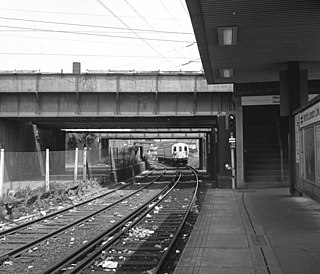
The West Ham station attack was a bombing and shooting attack at West Ham station in east London on 15 March 1976. A 5 lb (2.3 kg) bomb on a Metropolitan line train exploded prematurely in the front carriage of the train, injuring seven passengers. The bomb detonated prior to reaching the City of London, where it was thought the intended target was Liverpool Street station at rush hour. Adrian Vincent Donnelly, a Provisional Irish Republican Army (IRA) member, then shot Post Office engineer Peter Chalk in the chest, and killed train driver Julius Stephen, who had attempted to catch him. Donnelly exited the station to the street and threatened people with his revolver before PC Raymond Kiff caught up with him. Shouting "You English bastards!", Donnelly shot himself in the chest, but he survived and was apprehended by Kiff.
The 1974 Bristol bombing was a twin bomb attack carried out by the Provisional IRA in a shopping street in Bristol city centre on 18 December 1974. A bomb was placed in a holdall outside Dixons Photographic shop on Park Street which exploded just before 8 pm. Nine minutes later another more powerful bomb detonated in a dustbin 30 yards away. The blasts injured 20 people and was part of the IRA's bombing campaign in England. The IRA gave a telephone warning for the first bomb but not the second one.
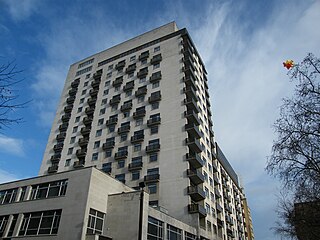
On 19 January 1975 the Provisional IRA's Balcombe Street Gang opened fire with automatic weapons on two hotels in London, England. Twelve people were injured by broken glass. The IRA carried out a similar attack a month before, and attacked one of the hotels again a few months after.

The Talbot Arms pub bombing took place on 30 November 1974, and was carried out by the Provisional Irish Republican Army (IRA). Eight people were injured in the attack, which involved the IRA throwing homemade bombs through the pub's window. Only one of the devices exploded; the other was taken as evidence and used to discover how the unit assembled its devices.

The Finchley Road bombings occurred on 2 October 1993, when the Provisional Irish Republican Army (IRA) detonated three time bombs on Finchley Road in north London, England. Telephoned warnings were sent six minutes beforehand, at approximately 00:26 UTC, but five people were injured from falling glass as a result of the blasts, and damage was caused to some shops and flats in the surrounding area. The three bombs were planted outside a Domino's Pizza restaurant, a travel agent, and offices of the St. Pancras Building Society. Later, anti-terrorist officers discovered and subsequently safely detonated a fourth bomb in a controlled environment, 1 mile (1.6 km) north of the initial bombings, in Golders Green. Two days later, on 4 October, the IRA detonated four more bombs in north London, two in Tottenham Lane and two more in Archway Road resulting in four injuries.
References
- ↑ Robinson, Eugene (13 October 1992). "BOMB IN LONDON PUB INJURES SEVEN" – via www.washingtonpost.com.
- ↑ "IRA pub blast victim dies of his injuries" . Independent.co.uk . 14 October 1992. Archived from the original on 25 May 2022.
- ↑ and, William E. Schmidt (13 October 1992). "5 HURT IN LONDON BY ANOTHER BOMB". The New York Times.